|
Report from
Europe
European wood flooring imports slow to recover
Imports of wood flooring into the European Union
increased 4.9% to 29.7 million sq.m last year after
declining steadily between 2010 and 2013. In 2014, woodflooring
deliveries from China, the single largest supplier,
increased by 4.9% to 18.6 million sq.m.
China accounted for 63% of total EU imports in 2014,
exactly the same proportion as the previous year (Chart 1).
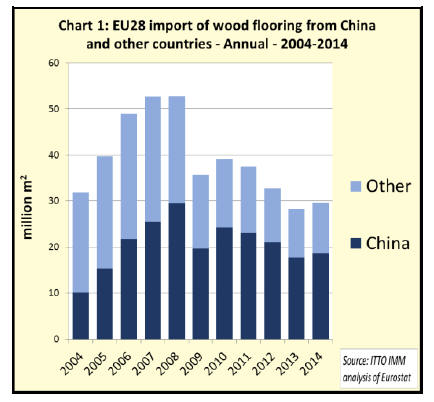
In spite of the recent growth, imports in 2014 were still
well below the record levels achieved between 2005 and
2008. There has been no significant recovery from the
slump during the financial crisis when imports plummeted
from 52.8 million sq.m in 2008 to just 35.6 million sq.m in
2009.
While European wood flooring imports were up for the
whole of 2014, they slowed towards the end of 2014,
particularly from China (Chart 2).
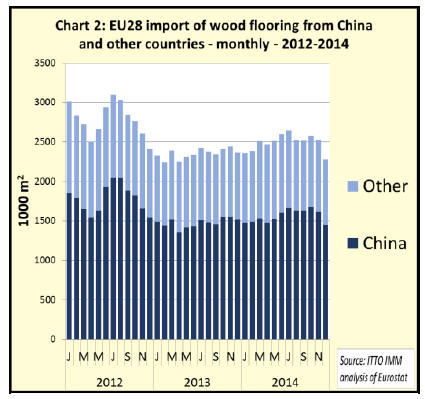
Over the long term, EU imports of wood flooring from
China have been more stable than from other countries
(Chart 3). Of major tropical supplying countries, imports
from Brazil, Indonesia, Thailand and Ivory Coast have
fallen considerably in the last 5 years.
Last year imports from Brazil recovered slightly (+9.2% to
678,000 sq.m), while imports continued to decline from
Indonesia (-6.6% to 1.4 million sq.m) and Thailand (-17%
to 111,000 sq.m). Imports from Ivory Coast fell a further
15% in 2014 and are now negligible.
In contrast, EU imports from Malaysia have been rising in
the last five years and increased again in 2014 (+6.5% to
1.3 million sq.m). Imports also increased by 20% from
Vietnam in 2014, but from a small base.
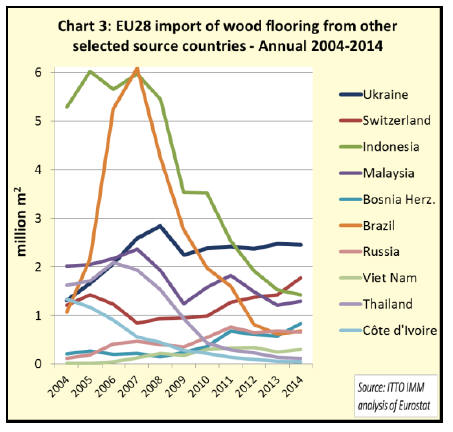
Of temperate countries, EU imports from Switzerland and
Bosnia-Herzegovina have been rising in recent years, and
this trend continued in 2014. Imports from Switzerland
were up 25% at 1.8 million sq.m, while imports Bosnia-
Herzegovina increased 44% to 0.8 million sq.m
respectively.
On the other hand, imports from the Ukraine were down
by 0.8% to 2.4 million sq.m. Imports from Russia fell
2.6% to 680,000 sq.m.
Trends in wood flooring imports by individual EU
Member States varied widely depending on economic
conditions (Chart 4).

Imports from outside of the EU into the UK, where there
was a robust recovery in construction sector activity last
year, recorded double-digit growth of 13% to 5.79 million
sq.m in 2014. Imports into Germany also increased
strongly, by 14% to 4.72 million sq.m, while imports into
Belgium rose 7% to 3.92 million sq.m.
Imports into the Netherlands recovered to some degree in
2014 from the previous year‟s low, increasing 7% to 2.49
million sq.m. Imports into France also increased slightly in
2014, up 0.6% at 1.64 million sq.m. Imports into Italy
were unchanged in 2014 at 3.25 million sq.m.
On the other hand, deliveries of wood flooring from
outside the EU into Spain, which as recently as 2007 was
the largest EU destination, fell again by 8% to just
630,000 sq.m in 2014. This compares to Spanish imports
of over 10 million sq.m of wood flooring from outside the
EU in 2007.
Although construction activity is just beginning to pick up
again in Spain, consumers are extremely cost conscious
and are showing strong preference for cheaper laminate
and other non-wood alternatives to real wood products.
Deliveries from wood flooring from outside the EU into
Sweden also declined last year, by 5% to 2.53 million
sq.m. However the decline was mainly due to a sharp fall
in Swedish imports from Ukraine. Sweden‟s imports from
China increased in 2014.
Wood flooring consumption falls again
While total EU wood flooring imports increased in 2014,
the European Wood Flooring Federation (FEP) reports that
consumption probably declined last year in many
European countries.
According to an FEP estimate published by the
international parquet federation Global Flooring Alliance
(GFA), European wood flooring consumption fell 3.8% in
2014, after slipping 2.6% the year before. Consumption
was 82.7 million sq.m in 2013 and is believed to have
been around 80 million sq.m in 2014.
Considering the various European countries, the negative
trend identified by FEP in France and Italy in its
September market review has apparently continued
through the final quarter of the year.
Wood flooring consumption in Germany and Austria was
also slightly down from 2013 levels, after Germany had
shown a positive trend in the early months of 2014. Swiss
consumption was static last year, whereas Sweden and
Hungary showed slight increases.
When it comes to wood species, the FEP sees a continuing
dominance of oak in the overall sales mix, while the share
of exotic woods has declined further. Wider boards and
“natural look” flooring remains very popular, according to
the FEP.
Looking forward, the FEP expects “a stabilisation in the
European parquet business during 2015.
Much oak on display at Domotex
The lasting trend towards oak flooring was also apparent
at the Domotex flooring show in Germany during January.
The show attracted 1.323 exhibitors from 63 countries,
covering all sectors of the flooring industry. With a total of
around 40,000, visitor numbers were slightly higher this
year than at the comparable Domotex in 2013.
According to the American Hardwood Export Council
(AHEC), oak accounted for around 80-90% of most
Domotex wood flooring exhibitors‟ product sales. During
its visit to the show, AHEC also found that the “rustic oak
look is still very much in fashion, and European oak is the
preferred supply”. American white oak would primarily be
used in the architectural sector. AHEC also witnessed a
trend towards dark “smoked” oak.
In terms of product specifications AHEC noted that
Europe seemed to continue to move more towards using
engineered flooring instead of solid wood flooring.
Exhibitors also told AHEC that European wood flooring
sales were not improving much, as Europe‟s economy,
especially in the Eurozone, remained very fragile. To
compensate, many European flooring manufacturers are
now seeking to expand export sales outside Europe.
Domotex organiser Deutsche Messe reported similar
trends for wood and laminate flooring noting the emphasis
on rough-sawn, brushed and used-look surfaces. In
laminate flooring grey or blends of grey and beige –
"greige" – surfaces are expected to remain the top sellers,
while dark laminate floorings were less popular with
buyers. Some companies also displayed a new generation
of waterproof laminate flooring at Domotex.
European laminate flooring sales stagnate
European producers of laminate flooring sold 465 million
sq.m worldwide in 2014, compared to 463 million sq.m
the year before, according to statistics compiled by the
European Producers of Laminate Flooring (EPLF) and
published by GFA. This is a rise of just 0.4% over 2013
(Table 1).
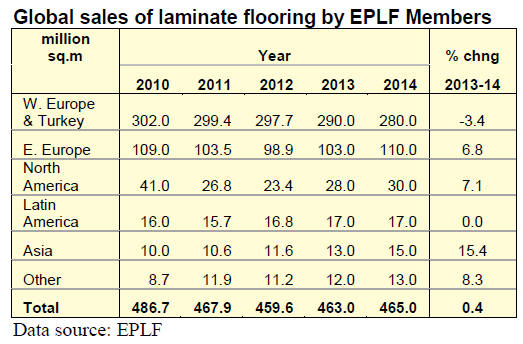
The regional markets showed contrasting trends in 2014,
according to EPLF. Within Europe, Western European
sales were slightly down compared to the previous year,
whereas sales in Eastern Europe experienced an upturn.
Sales in the core Western European markets (including
Turkey) declined by around 3.4% to 280 million sq.m in
2014. Germany, the single-largest market for European
laminated flooring, experienced renewed decline of around
4% to 69 million sq.m. EPLF believes that this was due to
a loss of market share to LVT floors.
Sales in Turkey were affected by the economic slow-down
combined with raw material shortages and temporary
production shutdowns for maintenance purposes. Overall,
sales in Turkey plummeted 18% to 54 million sq.m.
Sales in France remained stable at 39 million sq.m during
2014 in spite of the economic difficulties and rather
lacklustre building sector. The same is true for Spain,
where 14 million sq.m of laminate flooring were sold in
2014, the same as the previous year.
This seems to confirm reports from the wood flooring
sector that there is a growing preference for cheaper
laminates over real wood floors in those markets
particularly hard hit by the economic downturn.
Sales of laminate flooring in the UK increased by 10% to
32 million sq.m in 2014 on the back of a growing housing
sector and comparatively strong consumer confidence.
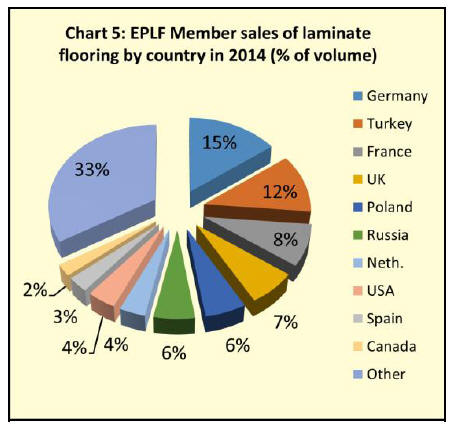
Rise in European laminate flooring exports
Total laminate flooring sales in Eastern Europe increased
by 7% to 110 million sq.m in 2014. Sales in Russia grew
by almost 13% to 27 million sq.m. in spite of the political
situation and adverse exchange rate trend.
This growth in the Russian market actually increased
towards the end of 2014.
The rise in sales meant that the Russian market for
European laminate flooring was as large as the Polish
market, which also 27 million sq.m last year, an increase
of 8%.
Sales in Romania and Hungary were also higher than the
year before, while sales in the Ukraine fell by 11%.
Most overseas markets for European laminate flooring
improved in 2014, with North America “showing
significant improvement” and Asia “even greater growth”,
according to EPLF. Turnover in North America had
started to rise as early as 2013 and this trend continued
through last year.
The market was particularly buoyant in the USA, where
EPLF members boosted their sales by almost 19% to 19
million sq.m. Sales in Canada were stable at 11 million
sq.m last year.
In the Asia-Pacific region, European producers achieved
sales growth of 15% to 15 million sq.m. Even stronger
growth of 25% to 5 million sq.m was witnessed in China,
where EPLF members supply primarily the high value
sector. In South America, EPLF members are reporting
stable sales of 17 million sq.m in 2014.
* The market information above has been generously provided
by the Chinese Forest Products Index Mechanism (FPI)
Correction
Our previous report said:
“the Swiss group Precious Woods Holding AG announced that
its business was in jeopardy”.
The company has advised that, while there was a concern raised
in their half-year report, a media release on 9 January, 2015
reported the successful refinancing and progress in their
business.
See:
http://www.preciouswoods.com/domains/preciouswoods_com/da
ta/free_docs/Media_Release_09_01_15_WDL_en_final.pdf
|